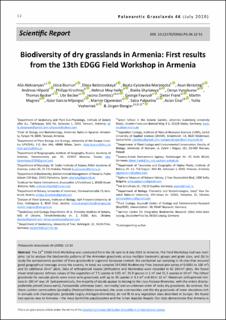Please use this identifier to cite or link to this item:
https://doi.org/10.21256/zhaw-20293Full metadata record
| DC Field | Value | Language |
|---|---|---|
| dc.contributor.author | Aleksanyan, Alla | - |
| dc.contributor.author | Biurrun, Idoia | - |
| dc.contributor.author | Belonovskaya, Elena | - |
| dc.contributor.author | Cykowska-Marzencka, Beata | - |
| dc.contributor.author | Berastegi, Asun | - |
| dc.contributor.author | Dembicz, Iwona | - |
| dc.contributor.author | Dengler, Jürgen | - |
| dc.date.accessioned | 2020-07-27T07:42:18Z | - |
| dc.date.available | 2020-07-27T07:42:18Z | - |
| dc.date.issued | 2020-07-15 | - |
| dc.identifier.issn | 2627-9827 | de_CH |
| dc.identifier.uri | https://digitalcollection.zhaw.ch/handle/11475/20293 | - |
| dc.description.abstract | The 13th EDGG Field Workshop was conducted from the 26 June to 6 July 2019 in Armenia. The Field Workshop had two main aims: (a) to analyse the biodiversity patterns of the Armenian grasslands across multiple taxonomic groups and grain sizes, and (b) to study the syntaxonomic position of these grasslands in a general European context. We conducted our sampling in 16 sites that ensured good geographical coverage across the country. In total, we sampled 29 EDGG Biodiversity Plots (nested-plot series of 0.0001 to 100 m²) and 53 additional 10-m2 plots. Data of orthopteroid insects (Orthoptera and Mantodea) were recorded in 42 100-m² plots. We found mean total species richness values of the vegetation of 7.5 species in 0.01 m², 31.9 species in 1 m² and 51.3 species in 10 m². The richest grasslands for vascular plants were meso-xeric grasslands with up to 35 species in 0.1 m² and 80 in 10 m². Maximum orthopteroid rich-ness in 100 m² was 14. Syntaxonomically, the majority of stands appear to belong to the class Festuco-Brometea, with the orders Brachy-podietalia pinnati (meso-xeric), Festucetalia valesiacae (xeric, non-rocky) and an unknown order of rocky dry grasslands. By contrast, the thorn-cushion communities (probably Onobrychidetea cornutae), the scree communities and the dry grasslands of lower elevations rich in annuals and chamaephytes (probably largely Astragalo-Brometea), do not fit to any vegetation class described in Europe. We found two species new to Armenia – the moss Syntrichia papillosissima and the lichen Aspicilia hispida. Our data demonstrate that Armenia is one of the Palaearctic hotspots of fine grain plant diversity. Both diversity patterns and syntaxonomy warrant in-depth studies, which are now possible with our comprehensive dataset. | de_CH |
| dc.language.iso | en | de_CH |
| dc.publisher | Eurasian Dry Grassland Group (EDGG) | de_CH |
| dc.relation.ispartof | Palaearctic Grasslands | de_CH |
| dc.rights | http://creativecommons.org/licenses/by-sa/4.0/ | de_CH |
| dc.subject | Armenia | de_CH |
| dc.subject | Biodiversity | de_CH |
| dc.subject.ddc | 577: Ökologie | de_CH |
| dc.title | Biodiversity of dry grasslands in Armenia : first results from the 13th EDGG Field Workshop in Armenia | de_CH |
| dc.type | Beitrag in wissenschaftlicher Zeitschrift | de_CH |
| dcterms.type | Text | de_CH |
| zhaw.departement | Life Sciences und Facility Management | de_CH |
| zhaw.organisationalunit | Institut für Umwelt und Natürliche Ressourcen (IUNR) | de_CH |
| dc.identifier.doi | 10.21570/EDGG.PG.46.12-51 | de_CH |
| dc.identifier.doi | 10.21256/zhaw-20293 | - |
| zhaw.funding.eu | No | de_CH |
| zhaw.issue | 46 | de_CH |
| zhaw.originated.zhaw | Yes | de_CH |
| zhaw.pages.end | 51 | de_CH |
| zhaw.pages.start | 12 | de_CH |
| zhaw.publication.status | publishedVersion | de_CH |
| zhaw.publication.review | Peer review (Publikation) | de_CH |
| zhaw.webfeed | Vegetationsökologie | de_CH |
| zhaw.author.additional | Yes | de_CH |
| zhaw.display.portrait | Yes | de_CH |
| Appears in collections: | Publikationen Life Sciences und Facility Management | |
Files in This Item:
| File | Description | Size | Format | |
|---|---|---|---|---|
| 2020_Aleksanyan_etal_13th-Field-Workshop_Palaearctic_Grasslands.pdf | 7.45 MB | Adobe PDF |  View/Open |
Show simple item record
Aleksanyan, A., Biurrun, I., Belonovskaya, E., Cykowska-Marzencka, B., Berastegi, A., Dembicz, I., & Dengler, J. (2020). Biodiversity of dry grasslands in Armenia : first results from the 13th EDGG Field Workshop in Armenia. Palaearctic Grasslands, 46, 12–51. https://doi.org/10.21570/EDGG.PG.46.12-51
Aleksanyan, A. et al. (2020) ‘Biodiversity of dry grasslands in Armenia : first results from the 13th EDGG Field Workshop in Armenia’, Palaearctic Grasslands, (46), pp. 12–51. Available at: https://doi.org/10.21570/EDGG.PG.46.12-51.
A. Aleksanyan et al., “Biodiversity of dry grasslands in Armenia : first results from the 13th EDGG Field Workshop in Armenia,” Palaearctic Grasslands, no. 46, pp. 12–51, Jul. 2020, doi: 10.21570/EDGG.PG.46.12-51.
ALEKSANYAN, Alla, Idoia BIURRUN, Elena BELONOVSKAYA, Beata CYKOWSKA-MARZENCKA, Asun BERASTEGI, Iwona DEMBICZ und Jürgen DENGLER, 2020. Biodiversity of dry grasslands in Armenia : first results from the 13th EDGG Field Workshop in Armenia. Palaearctic Grasslands. 15 Juli 2020. Nr. 46, S. 12–51. DOI 10.21570/EDGG.PG.46.12-51
Aleksanyan, Alla, Idoia Biurrun, Elena Belonovskaya, Beata Cykowska-Marzencka, Asun Berastegi, Iwona Dembicz, and Jürgen Dengler. 2020. “Biodiversity of Dry Grasslands in Armenia : First Results from the 13th EDGG Field Workshop in Armenia.” Palaearctic Grasslands, no. 46 (July): 12–51. https://doi.org/10.21570/EDGG.PG.46.12-51.
Aleksanyan, Alla, et al. “Biodiversity of Dry Grasslands in Armenia : First Results from the 13th EDGG Field Workshop in Armenia.” Palaearctic Grasslands, no. 46, July 2020, pp. 12–51, https://doi.org/10.21570/EDGG.PG.46.12-51.
Items in DSpace are protected by copyright, with all rights reserved, unless otherwise indicated.